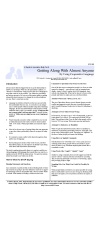Better communication – better understanding
The ladder of inference is a concept developed by C. Argyris to explain common thinking and communication processes and to help us become more aware of how we interpret the world around us, and improve communication so it builds better understanding.
First, it’s predicated on the idea that we (the information processors) interpret data to make meaning and make sense of it. So, first we have available data, which we then select to process, interpret, and finally end up drawing conclusions. The conclusions we draw are not objective, but subjective, since at each step we color or bias the process depending on our experience, or tinted glasses.
So, fundamental is the notion that what we take from a communication is what WE create.
Unfortunately, as we go up the ladder of inference, we often are not aware of the leaps and interpretations we make. And, we often mistake our conclusions as objective reality. That makes it difficult to communicate when two people draw conclusions, apparently from the same information, and see these conclusions as objective reality.
The ladder of inference is a reminder that, when communicating, we need to communicate not just our subjective conclusions, but our reasoning process and assumptions that underlie the conclusions. Otherwise we cannot get at the real sources of disagreement which lie in our assumptions rather than our conclusions.
In other words, the ladder of inference, developed by Chris Argyris, emphasizes that the conclusions we draw during communication are subjective rather than objective. Our experiences and biases influence each step of the inference process. It is crucial to recognize that what we perceive from a conversation is what we ourselves create. Often, we are unaware of the leaps and interpretations we make while ascending the ladder, mistakenly assuming our conclusions are objective reality. Effective communication necessitates sharing not only our subjective conclusions but also the underlying reasoning and assumptions. This approach uncovers the true sources of disagreement, which often lie within our assumptions rather than our conclusions.






